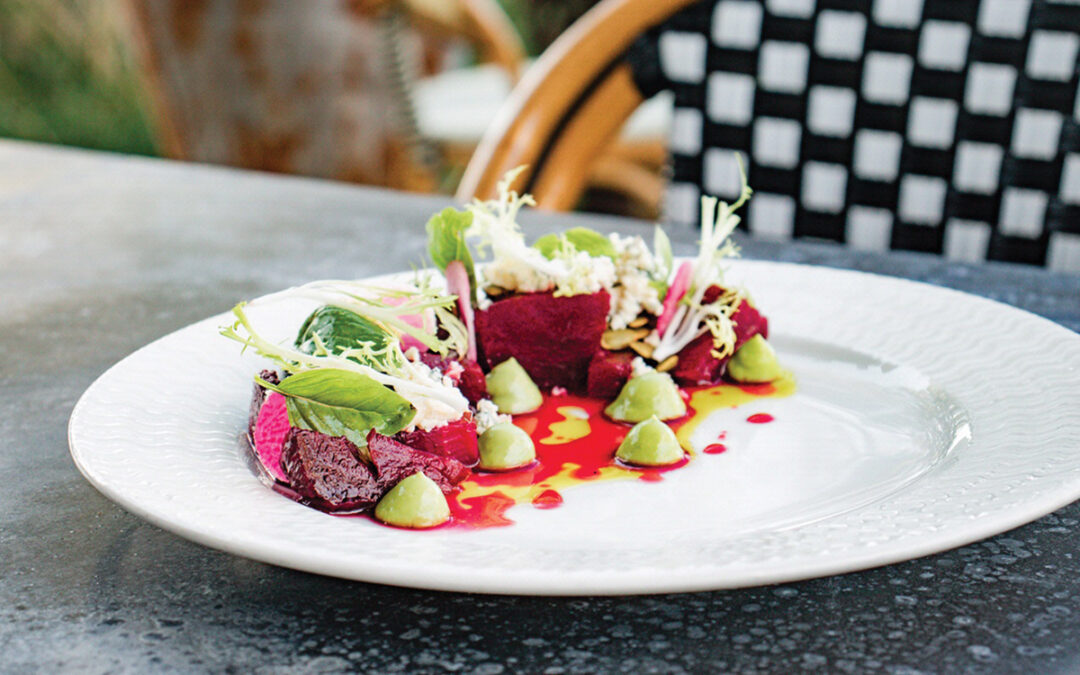As a child in Cleveland, Mary Frances Robinson used to visit the Cleveland Art Museum to admire the works of famous artists from the past. She liked to draw and paint herself and often wondered whether she could ever produce anything like the old masters’ canvases. Decades later, the answer is clear. No, she can’t paint like those august luminaries. What she can do, however, is paint in her own vivid style, which is usually referred to as “primitive” or “naïve.” In that, she is continuing the tradition of generations of self-taught artists who follow their own muse, usually creating images that are the product of their particular experience and culture. In a small study in her house near Sea- World, Robinson’s bright, happy paintings cover the walls on all sides. One of her favorite themes is the small rural homestead buzzing with daily activity — a child on a tire swing, a woman pumping water, another washing clothes, men tending their horses, chickens underfoot, etc. More often than not, a multicolored quilt is airing on a clothesline under a blue summer sky.
Years ago, she had witnessed a similar scene when she first visited her new mother-in-law on a farm in Mississippi. “She had a quilt on a clothesline, and she was using a wash pot like the one you see in that picture,” says Robinson, pointing to a specific painting featuring a large black-iron vessel that, she explains, was commonly used for all sorts of purposes in rural households. At the time, she took photos of her surroundings but did nothing with them for years, until her youngest child was ready to start school. “Then I pulled out those photos and started painting,” she says. “It was 1983, and we were already living in San Antonio, and I was a member of the City Art League. They had an exhibit in front of the Alamo, and my painting sold in the first hour.”
That was all the encouragement she needed. From there on, Robinson — who goes by M.F. Robinson — would take trips with her family throughout the South in search of old farmhouses, which she often found dilapidated and abandoned. “They were falling down, but when I painted them, I would put them back up and put the families back in,” she says with such warmth that it is clear that this was as much of an emotional as aesthetic journey for her. “That’s what my paintings represent — a certain time when family was very important and quilts were important,” she explains. “Mothers would use old dresses to make those quilts. In my paintings, the families are working together in harmony. That’s what it was all about, families sticking together. They had to work together in order to survive. Just about everything you see in these paintings my husband had on the farm he grew up on.” Other paintings depict church and small town life, some representing a more recent time period with black and white kids playing together, and there is one featuring a pretty Victorian house surrounded by flower gardens. Inspired by houses in the King William district, the latter painting belongs to a series that seems to appeal to owners of bed and breakfast establishments, notes the painter.
High on one wall, however, stands a different piece altogether. Painted in separate squares to resemble a quilt, and “hanging” on a painted clothesline, the work chronicles African-American history as interpreted by the artist. Called appropriately History Quilt, the canvas was in a Carver Community Cultural Center show back in the ’80s. Though she has had offers from interested buyers, she refuses to sell it. Otherwise, she is happy to part with her creations, which sell for $2,000 to $3,000, with a few going for as much as $10,000. At first she tried to reach potential buyers through galleries here in San Antonio, “but you couldn’t make any money that way.” So, accompanied by her husband, Hollis, a former military man, Robinson became a regular on the art show circuit, where her work was in demand.
She received five awards in five different years from the Cherry Creek Art Festival in Denver, including the Gold Pinnacle Award for designing the event’s 1996 poster, the first black woman to win the poster competition. Her work was also recognized as Best of Category (oils and acrylics) at the 1997 Vail, Colo., Art Festival and got Best of Show two years later at the St. Louis Art Fair.
Much as she enjoyed the festive atmosphere and the camaraderie with other artists during these events — not to mention lucrative business — travel and preparations for the shows were always stressful. Two years ago, Hollis suffered a heart attack while they were taking part in the Round Top art fest, which forced them to change course. The public can now see her work at the Gallery at Round Top, where she hopes to show her art twice a year. Though she also has a Web site, she’s been soured on Internet exposure ever since she learned that some people can download images straight from a site without ever paying a cent. In addition, a Tennessee man who years ago bought a bunch of her prints continues to sell her images through his own site, something that irks her considerably because she suspects that he’s been reprinting them.
She never took an art class
Robinson was reared by her paternal grandmother in Tennessee and Ohio and has never even met her mother, who was 13 when she gave birth to baby Mary Frances. “My grandmother was the only Mom and Dad I knew,” she says. “We were poor, but I didn’t know that; everyone else around us was in the same shape. She did the best she could. It’s thanks to her that I have this wonderful gift of art.” Grandma, a quilter, would have her quilting friends over once a week to sew and socialize. It was young Mary Frances’ job to choose the fabric patches the ladies would incorporate into their finished work. “I learned colors and patterns and grew to really love doing that,” she notes. Because Grandma was also very strict, not letting her granddaughter play outside with other kids or date as a teen, she had to entertain herself by drawing and painting. To earn money to buy paint, the budding artist would wash dishes or mop floors for the neighbors. Since the family could not afford art classes, she experimented on her own, using the colors the way they came out of the tube. No one was there to teach her how to mix them.
A style of her own
By the age of 16, Robinson had pretty much developed her style, even though at first she was disappointed that her images did not look anything like the ones she had admired at the museum. She fondly remembers how her grandmother would put up her sketches against the wall, proud of her granddaughter’s talent.
Though as a young woman she derived a great deal of satisfaction from her art, Robinson nevertheless put it all aside after marrying Hollis at 21 and becoming a mother of three children, the eldest of whom died tragically at 17. This is not a memory she wants to dwell on, but she proudly mentions her other two children, now adults — Evelyn, a teacher, and Rodney, a physician’s assistant. In a history-repeats-itself twist of fate, Robinson is currently raising her own two granddaughters, 12-year-old Alixandria and 10-year-old Hayley, who keep her pretty busy with their activities. She also has two other granddaughters in Arizona.
But this time, the now established artist is not giving up her own passion. Her “studio” is set up in the kitchen by the back windows, where she usually works on two canvases at the time. Because she uses oils, it takes days for fresh paint to dry, so she will alternate between the paintings to allow each to dry before adding new details. Most primitive artists today choose acrylics, she says, because they dry much faster, but “I have always liked oil colors and the way I can work with them.” Among her recent accomplishments she counts the United Way of San Antonio’s commission to design the 2003 campaign poster, which started her thinking about entering similar poster competitions held annually for Fiesta, but she has not gotten around to it yet. Another thing she would like to do more of is illustrations for children’s books. The one book she did years ago, Miss Geneva’s Lantern, is still available through Amazon.com. Her naïve style is, of course, perfectly suited for that sort of thing.
In her own paintings she is considering introducing different themes and trying out a looser, more contemporary style. “I sell these,” she says, motioning toward the pictures on the walls. “OK, but why not do something that’s going to be more fun?”
But on this day in mid-November, her immediate concern has to do with incorporating Christmassy elements into her happy-family images to satisfy a request from the Round Top gallery. A few Christmas trees would probably be good and maybe a little snow. The latter worries her a bit. Here in Texas, people don’t like snowy scenes, she observes. When she had some of those in the past, they ended up with buyers in Chicago and Detroit. Even autumn leaves, considered by many one of nature’s prettiest expressions, don’t seem to appeal to Texans. In the Lone Star State, we love summer, sunshine and blue skies.
And so does Robinson, actually. “I couldn’t paint the way I paint without sunshine,” she says. “Here, it’s sunny, and people smile at you when you go out and make you feel good. That’s what life is all about. We love Texas.”
Author: Jasmina Wellinghoff









0 Comments